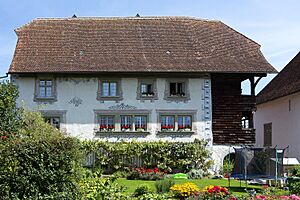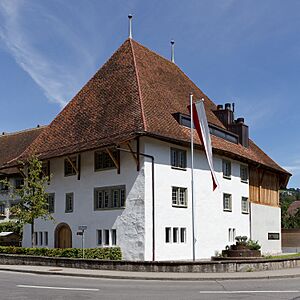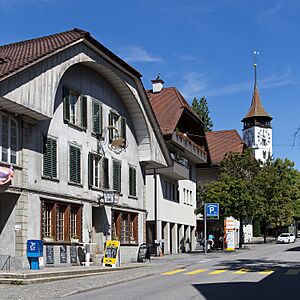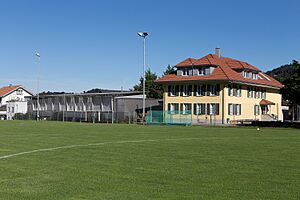Steffisburg facts for kids
Quick facts for kids
Steffisburg
|
||
|---|---|---|
 |
||
|
||
| Country | Switzerland | |
| Canton | Bern | |
| District | Thun | |
| Area | ||
| • Total | 14.81 km2 (5.72 sq mi) | |
| Elevation | 585 m (1,919 ft) | |
| Population
(Dec 2020 )
|
||
| • Total | 15,991 | |
| • Density | 1,079.7/km2 (2,796.5/sq mi) | |
| Postal code |
3612,3613
|
|
| Surrounded by | Fahrni, Heimberg, Homberg, Schwendibach, Thun | |
| Twin towns | Jindrichuv Hradec (Czech Republic) | |
Steffisburg is a town in Switzerland, located in the canton of Bern. It's part of the Thun area. On January 1, 2020, the nearby town of Schwendibach joined Steffisburg.
Contents
A Look Back in Time
Steffisburg was first mentioned in official papers in 1133. Back then, it was called Stevensburc. It used to be known by its French name, Steffisbourg.
People have lived in the Steffisburg area for a very long time. There is proof of settlements from the Neolithic (New Stone Age) and Bronze Age. Even traces of an ancient Roman site were found in a place called Schwäbis. Graves from the Early Middle Ages were also discovered.
In the Middle Ages, a powerful family called von Heimberg owned the land. Later, the Kyburg family took over. They made Steffisburg a special area ruled by knights who served them. One of these knight families, the von Kien, built a building known as the Kleine Höchhus in the 1300s. This building is one of the oldest in Steffisburg today.
Becoming Part of Bern
In 1382, a war started between the Kyburg family and the Old Swiss Confederacy, which included Bern. Bern won the war and bought the city of Thun and all the lands around it, including Steffisburg. This happened in the 15th century.
In 1480, a Bernese leader named Heinrich Matter built the Grosse Höchhus. It was built near the Kleine Höchhus and on the remains of an old castle. Even though it was rebuilt many times, it still looks much like it did back then.
Under Bernese rule, Steffisburg kept some independence. It had its own laws, first written down in 1405. These laws stayed in use until 1834! The town even had its own soldiers who fought under their own flag. In the 1600s, some farmers in Steffisburg joined a revolt against the cities of Thun and Bern. Even though they didn't win, Steffisburg remained an important local center.
Church and Economy
Steffisburg's main church was first built a very long time ago, around the 7th or 8th century. It was rebuilt in the 9th or 10th century. In 1224, it was known as the Church of St. Stephan. In 1528, Bern became Protestant, and so did the church in Steffisburg. The current church building was built in 1681, using parts from the older church.
For a long time, people in Steffisburg worked in many different ways. Farmers grew crops in the valley and raised animals in the mountains during summer. There were also vineyards on sunny slopes. The Zulg river provided power for mills that ground grain, sawed wood, and even made gunpowder. Later, pottery and brick factories opened.
In the 1800s, new roads and railways helped Steffisburg grow. A road to the upper Emmental area opened in 1895. The Burgdorf-Thun railway arrived in 1899, and a tram to Thun and Interlaken started in 1913. Since 1900, many people have moved to Steffisburg to live close to jobs in Thun.
In 1850, the Swiss Army built a place called the Regie in Schwäbis to keep horses for cavalry. Later, it became a warehouse for military vehicles. In 2008, it was turned into a museum showing old army equipment.
Where is Steffisburg?
Steffisburg covers an area of about 13.5 square kilometers (5.2 square miles). About 42.6% of this land is used for farming, and 29.3% is covered by forests. The rest of the area, about 27.5%, has buildings and roads.
The town is located in the lower Zulg river valley and along the right side of the Aare river. Steffisburg itself has an old medieval village center and several neighborhoods like Au, Schwäbis, and Glockenthal.
Steffisburg's Coat of Arms
The coat of arms for Steffisburg shows a silver castle on a green hill, all on a red background.
People of Steffisburg
Steffisburg has a population of about 15,515 people (as of December 2012). About 10% of the people living here are from other countries.
Most people in Steffisburg (about 92.5%) speak German as their main language. Other languages spoken include Italian and Albanian.
In 2012, children and teenagers (up to 19 years old) made up about 18.8% of the population. Adults (20-64 years old) were 61%, and seniors (over 64 years old) were 20.3%.
Population Growth Over Time
The population of Steffisburg has grown a lot over the years:

How Steffisburg Works
In 2011, Steffisburg had a low unemployment rate of 1.98%. Many people work in Steffisburg. There are jobs in farming, manufacturing (making things), and services (like shops, restaurants, and healthcare).
Steffisburg is a place where more people leave to work in other towns than people come in to work. However, many people (about 42.9%) both live and work right in Steffisburg. About 19.6% of workers use public transportation, and 47.1% drive their own cars.
Important Sites
The Former Regie of Steffisburg, which used to house army horses and vehicles, is a very important historical site in Switzerland.
Religion
According to a 2000 survey, most people in Steffisburg (about 68.2%) belong to the Swiss Reformed Church. About 12.4% are Roman Catholic. There are also smaller groups of people who follow other Christian faiths, Islam, Buddhism, and Hinduism. About 6.4% of the population do not belong to any church.
Learning in Steffisburg
Steffisburg has ten kindergartens, eight primary schools, and two secondary schools. The school system in Bern canton starts with one year of optional kindergarten. Then, students go to six years of primary school. After that, they have three years of lower secondary school, where they are grouped by their abilities. After secondary school, students can continue their education or start an apprenticeship (learning a job while working).
In the 2012–13 school year, over 1,600 students attended classes in Steffisburg. Many of these students were from Switzerland, but some were from other countries or spoke a different language at home.
Steffisburg also has a public library called the Gemeindebiblothek. In 2008, it had over 10,000 books and other media, and people borrowed over 31,000 items that year.
Getting Around
Steffisburg has two train stations: Schwäbis and Steffisburg. These stations are on the Burgdorf–Thun line. You can catch regular trains from here to Thun, Konolfingen, and Solothurn.
Famous People from Steffisburg
- Otto Lanz (1865–1935) – A Swiss surgeon who was an expert on the thyroid gland and appendicitis.
- Ana-Maria Crnogorčević (born 1990) – A Swiss footballer (soccer player).
- Colin Trachsel (born 1997) – A Swiss footballer who plays for FC Thun II.
Images for kids
See also
 In Spanish: Steffisburg para niños
In Spanish: Steffisburg para niños














